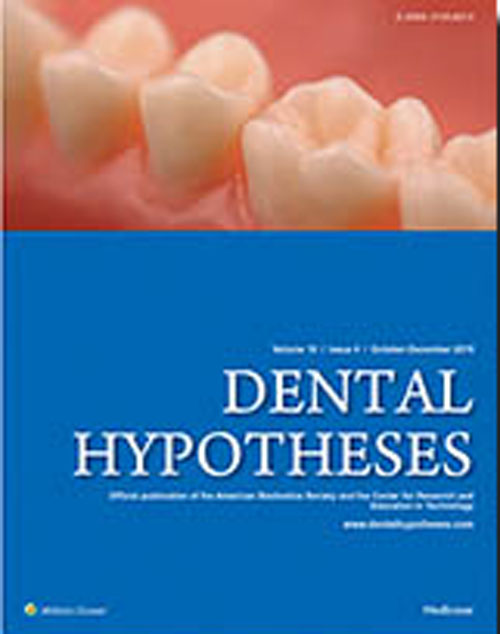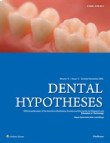فهرست مطالب

Dental Hypotheses
Volume:10 Issue: 4, Oct-Dec 2019
- تاریخ انتشار: 1398/11/23
- تعداد عناوین: 6
-
Pages 85-90Introduction
Endodontic treatment of necrotic immature teeth is quite challenging. Current concepts for revitalization of these teeth known as regenerative endodontic treatment (RET) is based on key elements necessary for tissue engineering including stem cells, three-dimensional (3D) scaffolds, and growth factors. Utilizing an applicable scaffold for narrow root canal space with adequate properties is essential for successful outcome. Fibrin-based products are materials with various advantages as a scaffold. This review article aims to discuss the properties of different types of fibrin-based products and debates whether they are appropriate scaffolds for RET or not?
MethodsAn electronic search was performed using databases such as Google Scholar, PubMed, PubMed Central, Science Direct, and Scopus. Keywords such as (“scaffold”) AND (“fibrin gel” OR “fibrin sealant” OR “fibrin glue” OR “fibrin tissue adhesive” OR “fibrin hydrogel” OR “platelet concentrate”) AND (“tooth” OR “teeth”) AND/OR (“regenerative endodontics” OR “dentistry”) were used. Exclusion criteria included studies published in a language other than English and abstracts from congress.
ResultsFibrin gel is a protein-based natural polymer hydrogel scaffold which can be easily used in the root canal. Platelet concentrates are autologous fibrin-based products used as scaffolds for RET with various favorable properties especially due to containing various growth factors.
ConclusionIt seems that fibrin gel and platelet concentrates have adequate properties for use in RET; however, more evidence is required regarding the clinical outcome of applying these products as scaffolds for RET.
Keywords: Fibrin, fibrin tissue adhesive, hydrogel, platelet concentrates, regenerative endodontics, tissue engineering, tissue scaffolds -
Pages 91-96Introduction
Osteotomy of the lateral wall in the lateral window approach for sinus floor elevation carries the risk of perforating the Schneiderian membrane. In this regard, this study aims to evaluate the relationship between age and lateral wall thickness (LWT) of the maxillary sinuses in patients with posterior edentulism.
Materials and MethodsA total of 311-cone beam computed tomography (CBCT) scans are analyzed. To measure the lateral sinus, the deepest point in the maxillary sinus floor is selected, a tangent line is drawn to this point, and another line is drawn perpendicular to the previous line. On the latter line, three points are marked at 3, 7, and 10 mm distance from the sinus floor and three lines are drawn passing through these points parallel to the tangent line. The thickness of the lateral sinus wall is measured on these lines. LWT of males and females is compared in different age groups and patients with complete or partial edentulism. The collected data are analyzed using the one-way ANOVA, Scheffe’s test, t-test, and Pearson’s correlation coefficient.
ResultsThere is a significant relationship between age and LWT of the maxillary sinuses. It is so that the LWT decreases as the age increases (P < 0.001). Also, the wall thickness of patients with complete and partial edentulism is significantly different (P < 0.05). There is no significant difference regarding gender (P > 0.05).
ConclusionAge and edentulism type affect the LWT of the maxillary sinuses.
Keywords: Edentulous, lateral wall approach, maxillary sinus -
Pages 97-102Introduction
The ultimate goal of mucogingival plastic surgery is to obtain complete root coverage and an optimal appearance. The aim of this study was to evaluate the efficacy of platelet-rich fibrin (PRF) with coronally advanced flap (CAF) compared to connective tissue graft (CTG) with CAF in the treatment of gingival recession (GR).
Material and MethodsA total of 20 patients were included in this randomized clinical study, presenting 40 GR Miller type I/II. The GR sides of patients were assigned randomly into test group (PRF + CAF) and control group (CTG + CAF). Clinical parameters, such as GR, probing depth (PD), clinical attachment level (CAL), and width of keratinized gingiva (WKG), were evaluated at baseline and 12 months later. Root coverage (RC %) and complete root coverage (CRC %) were assessed at 12 months post surgically. Statistical analysis was performed using paired, independent t-test and Mann–Whitney U test. Statistical significance was set at 0.05.
ResultsAt 12 months the mean (SD) GR was 0.20 ± 0.50 mm for test group and 0.05 ± 0.15 mm for control group, whereas the mean RC% was 95.32 ± 11.92 for PRF + CAF and 98.61 ± 4.37 for CTG + CAF. CRC was obtained in CTG + CAF with 90% and with 80% in PRF + CAF. CAL gain was 2.80 ± 0.28 mm and 2.49 ± 0.55 mm in test and control sites, respectively. The gain of WKG was 1.31 ± 0.45 mm and 1.85 ± 0.25 mm in test and control sites, respectively. All the values were not significantly different (P ≥ 0.05).
ConclusionUsing of PRF + CAF in the treatment of GR is a successful and effective treatment option and could serve as an alternative to CTGs.
Keywords: Gingiva, gingival recession, platelet-rich fibrin -
Pages 103-107Introduction
The oral microbiome is a complex community whose composition results from multiple interactions among different microorganisms and with the host. Predatory prokaryotes are recognized as important balancing factors in different ecosystems. Among them Bdellovibrio bacteriovorus received special attention for its strong predatory behaviour against many human pathogens in the absence of any toxic or pathogenic effect, so that it was proposed as a live probiotic/antibiotic agent. This work aimed to evaluate if B. bacteriovorus is detected from samples of human oral and dental biofilm.
Materials and MethodsSamples of oral and dental biofilm were obtained from 20 adults of both sexes and processed for extraction of metagenomic DNA, to be used as templates for B. bacteriovorus-specific PCR reactions. Specificity of amplification products was confirmed by sequencing.
ResultsAll 20 dental biofilm samples and 12 of 20 (60%) oral biofilm samples were resulted PCR positive. The sequences of 17 of 32 PCR products (53.1%) showed 100% identity with the reference sequence; the sequences of 11 of 32 PCR products (34.4%) showed ≥99% identity, while the remaining 4 products (12.5%) showed identities ranging between <99% and ≥97%.
ConclusionsThis is the first survey specifically reporting the presence of B. bacteriovorus in the human oral cavity and suggests that bacterial predation is a relevant balancing factor for the oral microbiota. Demonstration that B. bacteriovorus is able to colonize the oral cavity gives strength to proposals of its use as a probiotic/antibiotic in the prevention/treatment of selected oral diseases.
Keywords: Bdellovibrio bacteriovorus, dental biofilm, oral biofilm, predatory bacteria -
Pages 108-111Introduction
Procedural errors might occur during the treatment of the root canal system as a consequence of uncontrollable factors by the clinician. The fracture of endodontic instruments is unpleasant occurrences that happen rather frequently in the endodontic clinic. The hypothesis: As metals are magnetized to some extents, the clinicians might be able to move separated stainless steel and NiTi rotary instruments by magnets from the canals out. Evaluation of the hypothesis: The instruments (Hand Stainless Steel and Rotary NiTi) are tried to move away through using magnets at the first stage of experiment. For the next steps, the blocks and extracted natural teeth can be utilized as a situation more clinically relevant.
Keywords: Canal, instrument fracture, magnetism, NiTi, permanent magnet, stainless steel


